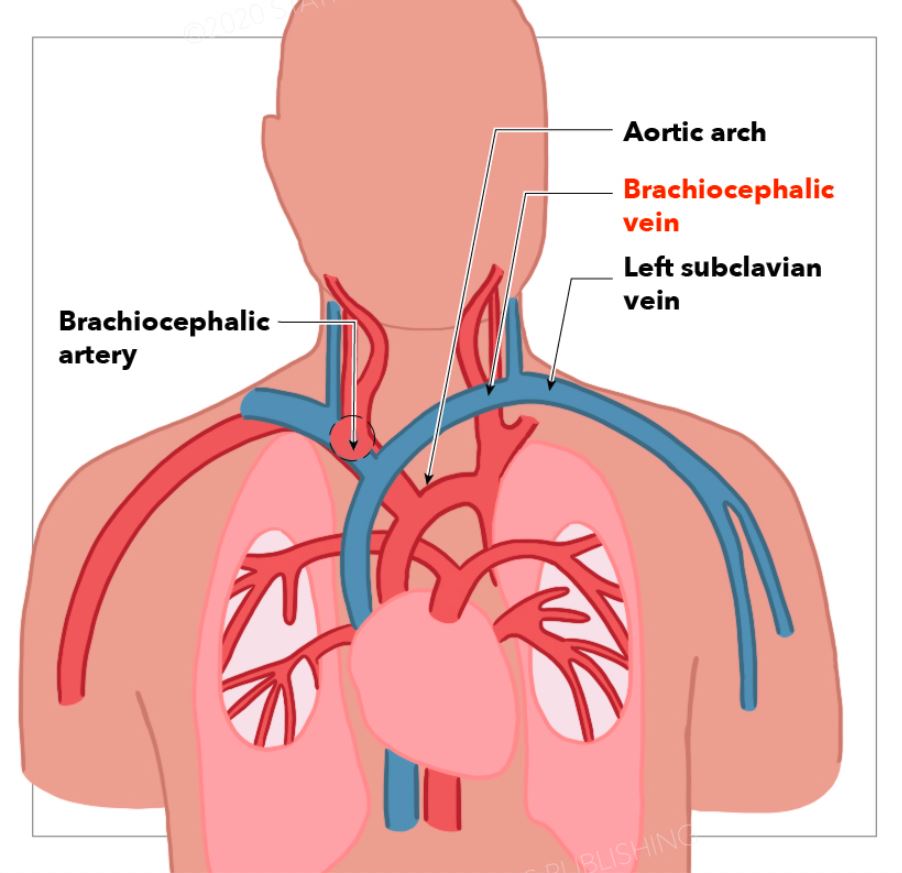[1]
Chen SJ, Liu KL, Chen HY, Chiu IS, Lee WJ, Wu MH, Li YW, Lue HC. Anomalous brachiocephalic vein: CT, embryology, and clinical implications. AJR. American journal of roentgenology. 2005 Apr:184(4):1235-40
[PubMed PMID: 15788602]
[2]
McNeill CJ, Sinnott JD, Howlett D. Bilateral brachiocephalic vein compression: an unusual and rare presentation of multinodular goitre. BMJ case reports. 2016 Oct 8:2016():. doi: 10.1136/bcr-2016-217074. Epub 2016 Oct 8
[PubMed PMID: 28049119]
Level 3 (low-level) evidence
[3]
Demos TC, Posniak HV, Pierce KL, Olson MC, Muscato M. Venous anomalies of the thorax. AJR. American journal of roentgenology. 2004 May:182(5):1139-50
[PubMed PMID: 15100109]
[4]
Sonavane SK, Milner DM, Singh SP, Abdel Aal AK, Shahir KS, Chaturvedi A. Comprehensive Imaging Review of the Superior Vena Cava. Radiographics : a review publication of the Radiological Society of North America, Inc. 2015 Nov-Dec:35(7):1873-92. doi: 10.1148/rg.2015150056. Epub 2015 Oct 9
[PubMed PMID: 26452112]
[5]
Murakami G, Sato T, Takiguchi T. Topographical anatomy of the bronchomediastinal lymph vessels: their relationships and formation of the collecting trunks. Archives of histology and cytology. 1990:53 Suppl():219-35
[PubMed PMID: 2252631]
[6]
Louzada AC, Lim SJ, Pallazzo JF, Silva VP, de Oliveira RV, Yoshio AM, de Araújo-Neto VJ, Leite AK, Silveira A, Simões C, Brandão LG, Matos LL, Cernea CR. Biometric measurements involving the terminal portion of the thoracic duct on left cervical level IV: an anatomic study. Anatomical science international. 2016 Jun:91(3):274-9. doi: 10.1007/s12565-015-0295-9. Epub 2015 Aug 14
[PubMed PMID: 26272628]
[7]
Irgau I, McNicholas KW. Mediastinal lipoblastoma involving the left innominate vein and the left phrenic nerve. Journal of pediatric surgery. 1998 Oct:33(10):1540-2
[PubMed PMID: 9802809]
[8]
Deslauriers J. Anatomy of the neck and cervicothoracic junction. Thoracic surgery clinics. 2007 Nov:17(4):529-47. doi: 10.1016/j.thorsurg.2006.12.009. Epub
[PubMed PMID: 18271167]
[9]
Madej T, Ghazy T, Ouda A, Knaut M. The venous U-turn: a unique variant of total anomalous superior systemic venous return. European heart journal. 2016 Oct 1:37(37):1520. doi: 10.1093/eurheartj/ehw127. Epub 2016 Apr 3
[PubMed PMID: 27044880]
[10]
McPhee A, Shaikhrezai K, Berg G. Is it safe to divide and ligate the left innominate vein in complex cardiothoracic surgeries? Interactive cardiovascular and thoracic surgery. 2013 Sep:17(3):560-3. doi: 10.1093/icvts/ivt244. Epub 2013 Jun 4
[PubMed PMID: 23736661]
[11]
Shimizu N, Tanaka Y, Kuroda S, Nakamura H, Matsumoto G, Mitsui S, Sakai S, Minami K, Kimura K, Okamoto T, Hokka D, Maniwa Y. [Temporary Bypass with 5-Fr Catheter for Reconstruction of Superior Vena Cava]. Kyobu geka. The Japanese journal of thoracic surgery. 2018 Dec:71(13):1077-1080
[PubMed PMID: 30587745]
[12]
Sun X, Xu J, Xia R, Wang C, Yu Z, Zhang J, Bai X, Jin Y. Efficacy and safety of ultrasound-guided totally implantable venous access ports via the right innominate vein in adult patients with cancer: Single-centre experience and protocol. European journal of surgical oncology : the journal of the European Society of Surgical Oncology and the British Association of Surgical Oncology. 2019 Feb:45(2):275-278. doi: 10.1016/j.ejso.2018.07.048. Epub 2018 Jul 26
[PubMed PMID: 30087070]

